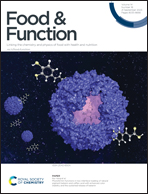Comparison of four digestion protocols on the physical characteristics of gastric digesta from cooked couscous using the Human Gastric Simulator†
Abstract
In vitro digestion is widely employed in food, nutraceutical and pharmaceutical research, and numerous in vitro gastric digestion protocols have been proposed, with a wide range of experimental conditions. Differences in the simulated gastric fluids (pH, mineral content, enzyme type and enzyme activity) of different digestion protocols may alter the results for the digestion of the same meal. This study aimed to investigate how variations in the gastric secretion rate and composition in four in vitro digestion protocols (Infogest Riddet, Infogest Semi-dynamic, UC Davis and United States Pharmacopeia) impacted the physical properties of the emptied gastric digesta. Cooked couscous was used as a model meal and subjected to simulated gastric digestion using a dynamic gastric model, the Human Gastric Simulator (HGS). The digesta were collected from the outlet of the HGS after 15, 30, 60, 90, 120, 150, or 180 min. The gastric emptying of dry matter, pH, rheological properties, and particle size were evaluated. The digestion protocol significantly influenced the solid content and moisture content of the digesta (p < 0.001), particles per gram of dry matter (p < 0.0001), gastric emptying of dry matter (p < 0.003), shear stress at 0.45 s−1 and consistency coefficient (p < 0.0001). The presence of NaHCO3 in the Infogest Riddet and Infogest Semi-dynamic gastric secretions provided an additional buffering effect and increased the digesta pH during gastric digestion. Similarly, the inclusion of mucin in the UC Davis protocol resulted in a higher flow and viscoelastic properties of the emptied digesta. The highest dilution of gastric content in the United States Pharmacopeia (USP) protocol resulted in larger particles emptied from the HGS and the longest gastric emptying half-time of all digestion protocols. These findings provide new insights into the impact of digestion protocols on the digesta properties, which can be beneficial for the design and standardization of in vitro digestion models.

- This article is part of the themed collection: Food & Function HOT Articles 2023


 Please wait while we load your content...
Please wait while we load your content...